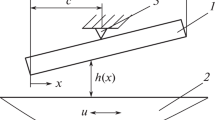Abstract
Investigation of the deformation characteristics of adaptive hydrostatic thrust bearings has been performed under extreme conditions, considering the relationship between viscosity and temperature of lubricating oil. A 3D model is generated, including the oil pad, the oil film and friction pairs. The oil film temperature field and the oil cavity pressure field have been calculated based on CFD. According to the lubrication theory and tribology principle, the force deformation, the thermal deformation, the force and thermal coupling deformation have been studied by using workbench simulation software, and the best working condition of adaptive hydrostatic thrust bearing is obtained. The results show that the load causes the table and the base to undergo inward elastic deformation, and the temperature causes them to undergo outward thermal deformation. The two deformations have opposite directions, and the deformations compensate each other. When the load is between 28 and 32t, the possibility of dry friction generated by the friction pair is low. The research results provide a theoretical basis for the stability of adaptive hydrostatic thrust bearings under extreme working conditions.































Similar content being viewed by others
References
Deling Wu, Jin Ma (1989) Influence of elastic deformation on the working performance of sliding bearings. J Beijing Univ Technol 04:67–72
Sharama SC, Jain SC, Bharuka DK (2002) Influence of recess shape on the performance of a capillary compensated circular thrust pad hydrostatic bearing. Tribol Int 35(6):347–356
Zhou X (2012) Study on the influence of machining quality and elastic deformation on the performance of dynamic and static pressure bearings. Chongqing University, Chongqing
SK Yadav, SC Sharma (2016) Finite element analysis of tilted thrust pad bearings of various recesses shapes considering thrust pad flexibility, 230(7):872-893
Li C (2017) Finite element analysis of mechanical deformation of thrust bearings. Mech Eng 11:110–112
Zhu B, Li YP, Wang WG, Lei MK (2019) Boundary slippage modeling and optimization of hydrophobic tilting pad thrust bearing with elastic deformation. Tribol Int 136:299–316
He Z, Xie H, Wang W, Deng D, Zhang C (2019) Influence of bearing bush deformation calculation model on lubrication characteristics of misaligned plain bearings. Lubricat Seal 44(06):31–40
Ettles C M M, Advani S. (1979) The control of thermal and elastic effects in thrust bearings. Peoc. of the 6th Leeds-Lyon Symp. on Trib., pp 105–116.
Wang X, Yamaguchi A (2002) Characteristics of hydrostatic bearing/seal parts for water hydraulic pumps and motors. Part 2: on eccentric loading and power losses. Tribol Int 35(7):435–442
Santos IF, KristianSen BU et al (2007) Geometry optization of hybrid tilting-pad journal bearings. In: 2007 Proceeding of the ASME/STLE International Joint Tribology Conference, San Diego, United States, pp 319-321.
Kim SI, Cho JW (2007) Thermal characteristic analysis of a high-precision centerless grinding machine for machining ferrules. Int J Precision Eng Manuf 23(1):32–37
Yadav SK, Sharma SC (2014) Performance of hydrostatic tilted thrust pad bearings of various recess shapes operating with non-Newtonian lubricant. Finite Elements Anal Des 87:43–55
Huang Z (2019) Study on thermal characteristics of CNC hydrostatic turntable oil-film considering viscosity effects. Univ Electron Sci Technol China 48(4):627–632
Li Y, Li X, Lai F, Sun X, Zhao Q (2018) Research on thermal deformation of thrust bearing thrust Disk. J Harbin Univ Sci Technol 23(02):120–123
Markin D, McCarthy DMC, Glavatskih SB (2003) A FEM approach to simulation of tilting-pad thrust bearing assemblies. Tribol Int 36:807–814
Xiaodong Yu, Wang Yu, Zhou D et al (2019) Heat transfer characteristics of high speed and heavy load hydrostatic bearing. IEEE Access 7:110770–110780
Xiaodong Yu, Zuo Xu, Liu C et al (2018) Oil film shape prediction of hydrostatic thrust bearing under the condition of high speed and heavy load. Ind Lubricat Tribol 70(7):1243–1250
Wang S (2016) Study on the load-bearing characteristics and fluid-solid thermal coupling of large-scale heavy-duty liquid hydrostatic turntable. Hunan University, Changsha
Mubing Yu, Xiaodong Yu, Zheng X, Jiang H (2019) Thermal-fluid-solid coupling deformation of hydrostatic thrust bearing friction pairs. Ind Lubricat Tribol 71(3):467–473
Pang Z (1981) Liquid-gas static pressure technology. Heilongjiang People's Publishing House, Heilongjiang
Chen Y, Sun G (1980) Principle and design of hydrostatic support. National Defense Industry Press
Ding Z (1989) Design of hydrostatic bearing. Shanghai Science and Technology Press
Adam Stansfield FM (2003) Application of Hydrostatic Bearing in Machine Tools. China Machine Press, Beijing
Zhang B (2003) Numerical methods of fluid dynamics. China Machine Press, Beijing
ANSYS, Inc (2007) ANSYS CFX-solver modeling guide. ANSYS Inc, Canonsburg
Wang F (2004) Calculation flow mechanics analyses—FLUENT software principle and applies. TsingHua University Press, Beijing
Han Z, Wang J, Lan X (2004) The FLUENT Fluid Project Simulates Calculating an Example and Applies. Press of Beijing Institute of Technology, Beijing
Acknowledgment
This research was financially supported by the National Natural Science Foundation of China (51375123) and the Natural Science Foundation of Heilongjiang Province (E2016040).
Author information
Authors and Affiliations
Corresponding author
Ethics declarations
Conflicts of interest
The authors declared no potential conflicts of interest with respect to the research, authorship and publication of this article.
Additional information
Technical Editor: Daniel Onofre de Almeida Cruz, D.Sc..
Publisher's Note
Springer Nature remains neutral with regard to jurisdictional claims in published maps and institutional affiliations.
Rights and permissions
About this article
Cite this article
Yu, X., Wang, F., Zhou, D. et al. Deformation characteristics of adaptive hydrostatic thrust bearing under extreme working conditions. J Braz. Soc. Mech. Sci. Eng. 42, 489 (2020). https://doi.org/10.1007/s40430-020-02571-4
Received:
Accepted:
Published:
DOI: https://doi.org/10.1007/s40430-020-02571-4



